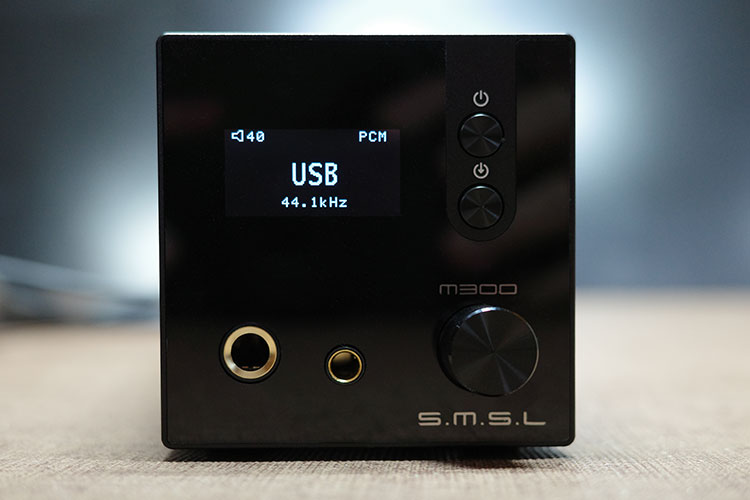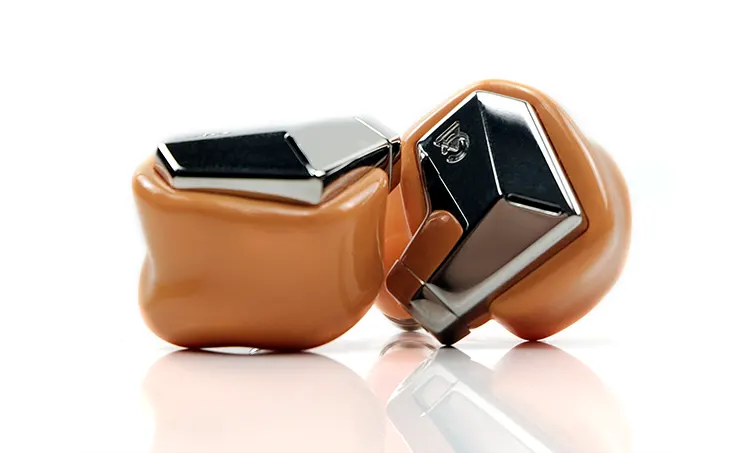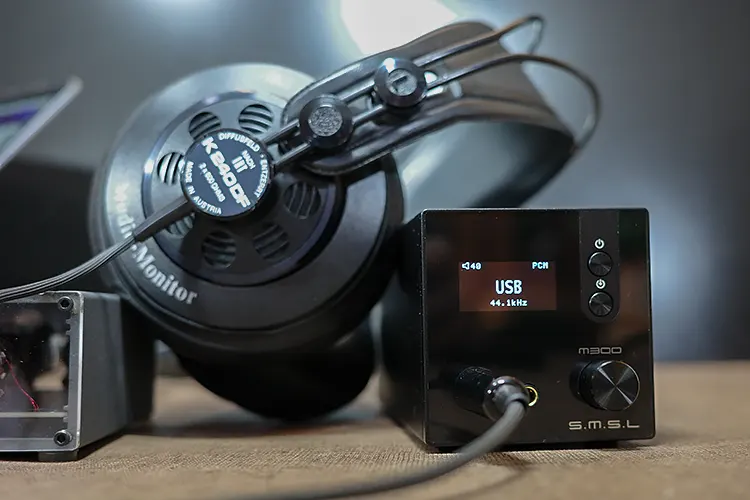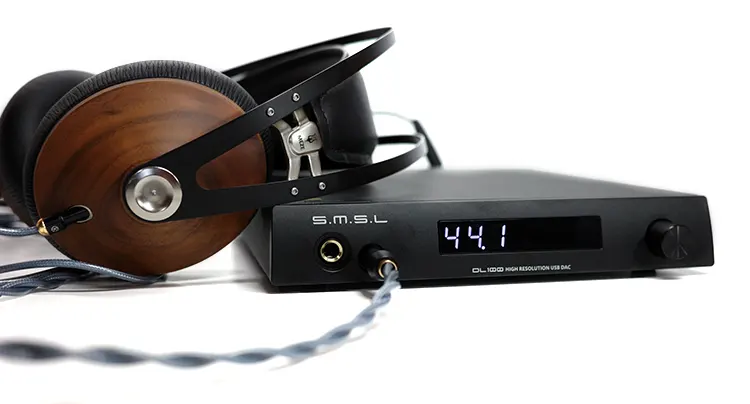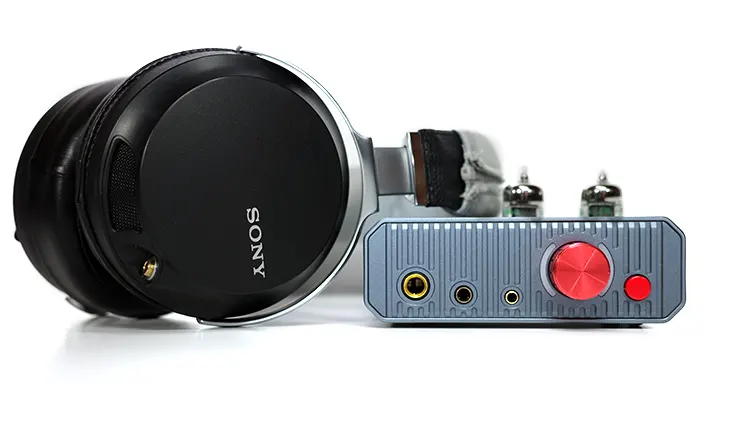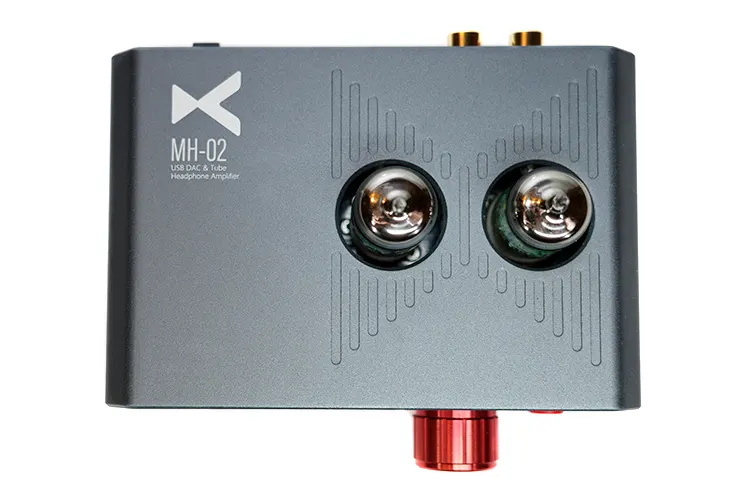Synergy
Connectivity
The SMSL M300 SE worked across many different sources, including using it as the front end (again) with my Oppo BDP-83 as a CD player, the HiBy R4 as a streaming source, and my MacBook Pro for the same purpose. BT pairing occurred seamlessly using the R4 and MBP as well.
My favorite pairing was using the M300 SE as a stand-alone DAC, paired with the Geshelli Labs Erish2 though. For some reason, the duo was able to run the extremely needy voltage-wise SJY Horizon headphones without issue.
I have used more powerful amplifiers with the Horizon that could not operate as easily (or musically) as the duo here. I found this duo extremely attractive as a desktop option as a result.
My next favorite connection was the oppo, and I spent many of the testing hours connected to it enjoying both IEMs (Spirit Torino Twin Pulse Beryllium) and headphones (Meze Audio 99 Classics, again as well as the AKG 240DF).
A clear and crisp neutral sound came forth from the duo, with a solid bass carrying forth. This setup stayed true to CD-level audio quality.
The HiBy R4 was connected using the USB-C connection on both ends, along with a dedicated power plug in the 5V USB-C. This would be my preferred budget option due to the affordability of both and provides yet another example that quality sound need not cost an arm and a leg.
The R4’s slightly warmer sound came through like it was meant to be using the M300 SE, which shows how well the SMSL unit handles transparency.
Efficiency
Unlike the SMSL DL100, hard-to-drive headphones such as my 600Ω AKG240DF did not suffer, and I was able to drive them with ease.
The Kennerton Rognir, arguably easier to drive, did not suffer from the pairing, handling the volume input with aplomb. The very hard-to-drive SJY horizon played effortlessly when paired with the right amplifier here, too.
IEMs such as the Spirit Torino Twin Pulse Beryllium played without bother., as did the Kiwi Ears KE4. I do not own any seriously hard-to-drive IEMs, but those that perform at a high level such as the Spirit Torino, and Campfire Audio Supermoon came across as very musical.
Power
A pleasant surprise was the ability to drive high-impedance headphones such as the AKG 240DFs mentioned elsewhere. Normally, I need a powerful amplifier to drive the 600Ω unit, but the M300 SE easily drove the headphones to very loud listening levels.
Running the M300 SE as a pure DAC, you are only at the mercy of the connected amplifier. As noted above, models such as the Geshelli Labs Erish2 can easily drive high-impedance headphones.
Pairings
Running the M300 SE alone, the AKG240DFs were able to come across musically with enough verve to satiate my volume needs.
This pairing was used the most during my testing period (when not paired with the Erish2 & the SJY Horizon), mostly for ease of use. But that does not diminish the quality offered by the duo together.
I enjoy rotating the Spirit Torino Twin Pulse IEM into play, pulling it out regularly for reviews and personal listening.
With the M300 SE and the R4, I found it worked quite well (better than the DL100 pairing), with a nice amount of added clarity. The M300 SE continues to amaze me with its qualities, allowing the connected listening IEM or headphones to show its mettle.
My favorite though, was when I ran the M300 SE as a stand-alone DAC, paired through the XLR connections to the Geshelli Labs Erish2 (mentioned several times already) using the SJY Horizon.
These are very hard headphones to drive adequately, and the mating with the duo DAC/Amp afforded not only adequate voltage to run the headphones but also sound commensurate with the ability the Horizon provides.
The levels of detail provided by the headphones came across naturally with a musical note that was commensurate with its neutral character perfectly.
Select Comparisons
SMSL DL100
Features
With 4 CS43131 chips (instead of the two), and TI’s OPA1612A Op-amps, the DL100’s DAC can offer a wide range of digital connections, including an HDMI (ARC) cable.
Along with a dual USB connection (1.1 & 2.0 for easy game system connection), it makes the DL100 a potential system choice for HDMI ARC TV users.
The third generation XMOS XU-316 (same as the M300 SE) is capable of DSD Native 256 (M300 SE up to DSD512), PCM up to 32bit/768kHz, and DoP64. The DL100 also carries more power than its cousin the M300 SE by approximately 16 times at 300Ω. But as we will find out, that does not seem to matter.
Five PCM filters allow for personalization ranging from NOS (no sampling), FL1 (Fast and Low-latency), FL2 (Fast and Phase-compensated), FL3 (Slow and Low-latency), to F4 (Slow and Phase-compensated), just like the M300 SE.
That DL100’s amplifier can deliver up to 1.5W at 32Ω and 3.0W at 16Ω making it adequately powerful on its own. The power implementation is also kept separate from the DAC circuitry, which helps keep potential interference to a minimum.
The Qualcomm QCC5125 BT 5.1 module supports LDAC, aptX, aptX HD, AAC, and SBD giving you all of the common wireless codecs at your fingertips. The M300 SE only carries BT 5.0.
Design
There is no getting around the diminutive size of the DL100, especially with how thin it is, height-wise. This can give the user many beneficial options for placing the unit within their system.
However, the differentiation in shape between the two affords the user different placement options. I like the M300 SE shape better.
The matte black finish on all sides makes for an unassuming piece of gear too, which means it can go about its business without drawing too much attention to itself.
With its 196 x 31 x 206mm diminutive size (7.7×1.2×8.1in) and weighing in at a little over a kilo at 1.05kg (2.31 lbs.), the DL100 is quite a compact little integrated desktop DAC and headphone amplifier, but still twice as heavy as the M300 SE.
Performance
The sound emanating from the DL100 varied by source input naturally, and the music source coming from each. I did prefer the balanced output for listening. The balanced option helped to spread the soundstage out, allowing the instruments to exercise in their own space.
The DL100 promotes a neutral signature, displaying warmth and richness only if the source or music played does so. This comes across as one of the more neutral DAC/amps I have tried of late, that was until I heard the M300 SE, which promotes neutrality at its best.
Its lows offer aplomb when called upon, but without bloating the sound, or carrying over into the mids, which I appreciated. The top-end reach will add a bit of sparkle and a distinct clarity to the notes, without becoming grating or harsh.
I did find the DL100 could not adequately drive high-impedance headphones like the M300 SE can, though. If you pair both with a dedicated amplifier, that gap diminishes but taken singularly, the M300 SE can drive headphones more easily.
xDuoo MH02
Features
The xDuoo MH02 is a Class A buffered transistor headphone amplifier that uses 6J1 tubes as the pre-amplifier, warming what might be a colder, more sterile sound.
Capable of decoding up to PCM 32bit/384kHz, MQA 32bit/384kHz, & DSD256 (M300 SE, DSD512) through the USB input, the characteristics fall right in line with this level of amplifier.
Keeping the Pre-amp and amplifier separate also contains potential noise interference, especially where tubes are concerned. The MH02 isolates each to help minimize interference and potential noise pitfalls. This isolation is one of the more isolated small amplifiers, keeping noise to a minimum.
Providing up to 1300MW(32Ω LOAD), the MH02 drives most higher-impedance headphones, too. A single CS43131 DAC chip (as opposed to the 2 in the M300 SE) carries a low noise floor along with high decoding abilities.
This helps isolate any of the typical tube “ping” you might hear when touching the surfaces of the MH02 when it is turned on. The slotted shape is as much of a help as the isolation in my opinion.
The gain switch can add either 12dB or 18dB for headphones which need a higher output to perform. Since the “normal” output most likely would be the 12dB gain, it should be considered a baseline, meaning a +6dB gain between each setting is more realistic.
With a line-out, the MH02 can be utilized as a pre-amp (just like the M300 SE) for those who want to add another amplifier to the chain. There is also a built-in circuit protector, avoiding that familiar “pop” when turning on a unit such as this that carries tubes.
Design
The MH02 carries a small rounded, rectangular footprint, with the two tubes sticking out of the top adding to the aura.
The sandblasted aluminum shell carries “slots” to help dissipate heat giving the unit a more industrial look, especially with the gray coloring. And this helps isolate potential “pings” when tapping the unit.
Carrying 12 X 7.8 X 4.0CM dimensions and a svelte weight of 0.35kg makes the unit imminently placeable within your system.
The tube look will make you want to show it off, though, especially if you go tube rolling. This is about 190g less than the M300 SE.
Performance
Tube amplifiers usually promote a smoother, warmer signature, and the MH02 follows this but with a level of detail mostly on par with a Class-A amplifier of this class.
There is plenty of power to drive higher impedance headphones with ease mostly, and I rarely had to use the high gain setting.
When using high gain though, the midrange is elevated and enhanced, pushing it to the forefront, but without losing clarity on both ends too much. This is where the M300 SE stays more neutral in character, with less influence on the sound qualities.
The treble reach is smoothed by the tubes, and the bass digs a bit deeper, but without the familiar elongated, thumping notes typical of a tube amplifier. The M300 SE carries a stronger note up top, extending beyond what the MH02 can provide.
Limited by the stock tubes, the sound comes across as fairly typical of a tube amplifier, but without the overall smoothness often associated with such a unit. The sound is not nearly as detailed and clear as the M300 SE, but to me, the fun here is when you change tubes, giving a different sound characteristic.
Using the NOS GE tubes I purchased specifically for the MH-02, I enjoyed the added level of detail, which the stock tubes could not match.
The complementary nature of each signature from the M300 SE and MH02 affords two distinct sound signatures for your listening, which isn’t always a bad thing to have on hand.
There was also a more organic feel to it, which fit my expectations of what a good tube amplifier can provide. While I prefer a warmer, richer signature of tube amplifiers, the M300 SE’s character and versatility make a strong case for its merits.
My Verdict
With this review coming shortly after the SMSL RAW MDA-1, I was expecting similar results from the M300 SE. And, while there were similarities, the result varied quite a lot for me.
The ability to drive high-impedance headphones for one, and the ability to connect via XLR were two of the positives I came away with.
The sound coming from the M300 SE stays true to SMSL’s familial roots, which rely upon neutrality and accuracy of note. The M300 SE proves that quite well at a very affordable price.
If I could fault anything, it would be the lack of output options, which are limited to RCA and XLR. USB-C, coaxial, and optical inputs make for a formidable device, but having one of those as an output option would add to the versatility.
Even with that “lack of output options,” the M300 SE is a highly affordable, compact desktop headphone amplifier and DAC, that comes across as musically neutral and accurate. It has a multitude of features to consider, including the surprising ability to run higher-impedance headphones quite well.
The SMSL M300 SE is an affordable DAC that should be on the list of considerations.
SMSL M300 SE Technical Specifications
- Inputs: USB / Optical / Coaxial / Bluetooth
- Output Level: RCA 2.0Vrms XLR 4.0Vrms
- THD+N(UN-WTD): 0.00013% (-117dB)
- Dynamic range (UN-WTD): RCA 120dB XLR 132dB
- SNR (UN-WTD): 131dB
- Bluetooth: BT 5.0 ( support SBC)
- USB transmission: Asynchronous
- USB compatibility: Windows 7 / 8 / 8.1 / 10 Mac OS X10.6 or Later / Linux
- Bit depth: USB:1bit ~ 32bit
- Optical/coaxial: 16bit ~ 24bit
- Sampling rate: USB:44.1 ~ 768kHz DSD64, DSD128, DSD256, DSD512
- Optical/coaxial: 32 ~ 192kHz
- Power Consumption: 3W
- Standby power: <1W
- Size:70x73x165mm (9.09 x 7.17 x 4.41 inches, WxHxD)
- Weight: 0.54Kg

